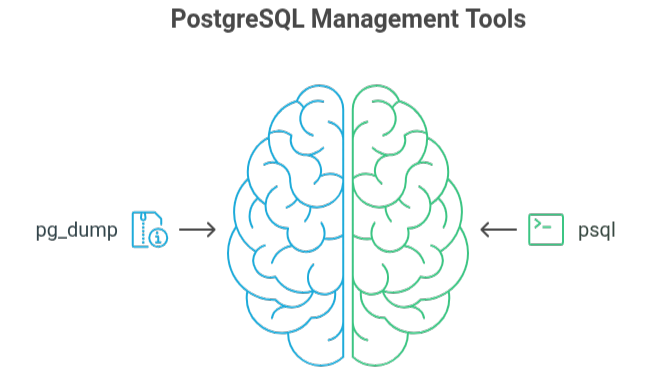Migrate a PostgreSQL database using pg_dump and psql for fast and secure backups. Our PostgreSQL Support team is ready to assist you.
Migrate a PostgreSQL Database Using pg_dump and psql
pg_dump and psql are essential tools for PostgreSQL databases. pg_dump creates full backups of schema and data, while psql allows you to run queries, manage objects, and restore backups. Together, they ensure data protection and full control over your database.
Introduction to pg_dump and psql

Managing a PostgreSQL database effectively requires the right tools. Two essential utilities, pg_dump and psql, help database administrators and developers maintain data integrity, perform backups, and handle migrations with ease.
pg_dump allows you to create a complete backup of your database by extracting its schema and data into a file. This backup file can be used to restore the database on the same server or transfer it to another machine. It ensures that your data remains safe and consistent even while the database is in use.
psql provides a powerful interface to interact with your PostgreSQL server. You can run SQL queries, explore database structures, and manage tables, users, and permissions directly from the terminal. It also allows you to execute scripts, which is useful for automating tasks or restoring data from pg_dump backups.
By combining these two tools, you can efficiently back up, migrate, and manage your databases while maintaining control over every aspect of your PostgreSQL environment.
Read next to learn how to backup and restore a PostgreSQL database using pg_dump and psql and ensure your data is always protected.
Backing Up a PostgreSQL Database
Protecting your PostgreSQL database is critical to avoid data loss, corruption, or accidental changes. Using pg_dump, you can create a complete backup of your database that includes both the schema and data. This backup can be used to restore the database or migrate it to another server.
To take a backup, start by opening the Command Prompt on Windows or the terminal on Linux. Use the pg_dump command to export your database to a file. Make sure to include the hostname, port, username, database name, and the path where you want to save the backup. Once you run the command, enter your database password and wait for the process to complete. You will then have a backup file ready to use.
On Windows, a sample command looks like this:
pg_dump -h postgresql-5428-0.cloudclusters.net -p 10018 -U pgs -d pgs -f D:/backup/pgs.bakOn Linux, the command would be:
pg_dump -h postgresql-5428-0.cloudclusters.net -p 10018 -U pgs -d pgs -f /tmp/pgs.bakCreating regular backups ensures your data is safe and allows you to recover quickly from any issue.
Restoring a PostgreSQL Database
You can restore a PostgreSQL database using psql by executing the backup file created with pg_dump. Start by creating a new or empty database.
Restore Command:
psql -U <username> -d <database_name> -f <path_to_backup_file.sql>Example:
psql -U postgres -d my_restored_db -f /home/user/backups/my_database_backup.sqlAlternative Method Using Input Redirection:
psql -U <username> -d <database_name> < <path_to_backup_file.sql>Advanced Backup and Restore Options
Advanced features in PostgreSQL and Commvault let you control backups, restore data selectively, and ensure portability across systems.
Custom Formats
Create compressed backups in PostgreSQL using custom or directory formats. These formats support parallel restoration and allow more control than plain-text backups.
Selective Restores
Restore only the data you need. Use pg_restore to select specific tables, schemas, or functions. Commvault lets you restore files to different locations or rename databases.
Portability
Custom and directory backups in PostgreSQL can be used across different hardware. Commvault ensures backups are compatible across operating systems.
These options help protect your data, reduce downtime, and simplify database management.
[Need assistance with a different issue? Our team is available 24/7.]
Conclusion
You can easily migrate a PostgreSQL database using pg_dump and psql by backing up, transferring, and restoring data while ensuring integrity and control.
In brief, our Support Experts demonstrated how to fix the “554 5.7.1 : Relay access denied” error.







0 Comments